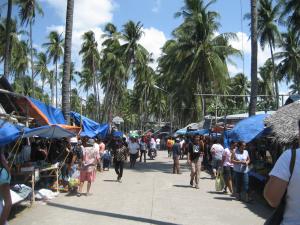Oh there it was, that familiar jagged coastline of Dumaguete. My heart did a little back flip. This is my favorite city in all of the Philippines, my dad's hometown. Though discovering new places is thrilling, I cannot resist the lure of this place I have come to love as my second home.
From my window seat on the plane, I could see the long stretch of beach to my right where we spent many memorable Easter breaks. To the left was the runway; we were heading for the part that jutted out into the water. That extended stretch of tarmac meant planes no longer had to screech to a stop within two seconds of touchdown. Now they ease up a little and do it in five. It also meant we lost our little spot on the rocks at the edge of the original strip, where we spent many nights stargazing and drinking rum and cokes – the "state" drink.
It had been three years, but it may as well have been twenty. The airport was exactly the same. I walked on the blazing hot tarmac alongside the cart which held our luggage. There are no carousels here; just strong armed porters who take your claim tags and join the pack to rummage through the rising pile of bags on the floor.At this point, as is always the case, the constant process of bumping into familiar faces in this small town begins. I counted three. It wasn’t officially Holy Week. The throngs of people were not expected until the next day. My cousin was outside, ready to whisk us off to our first order of the day – the Malatapay Market. This was my special request and the reason I stumbled out of bed at the ungodly hour of 5:00 a.m. to catch the first flight.
I don’t remember precisely when I was at Malatapay last since it was so long ago, but I recall the experience well. Often when you revisit a place from your childhood, you are startled by how much smaller it seems to have become. Not this time.
Malatapay is located about 20 minutes south of Dumaguete in the town of Zamboanguita. On a regular day, it is a quiet patch of coconut trees, huts and a beach that serves as the jump off point for Apo Island. It is in the middle of the week when it springs to life. Like a sleeping giant whose slumber is disturbed, it awakens with a roar and rages on all day.
You can’t miss the junction of Malatapay. The first sign is the long lines of trucks and cars parked carelessly on both sides of the highway. We see more trucks are being loaded with cattle, at which point we arrive at the entrance to Malatapay. Locals, tourists, animals, pedicabs spill out from the now cemented path that leads through the market and down to the beach. My cousin slowly steers the car into this sea of chaos, carefully, not to harm any stray goats or pigs.
We are in the thick of it
I stare through the window in disbelief. When did it get so big? We reach a makeshift area where we park under the shade of coconut trees, next to a man napping on the roof of his jeep; a sullen looking cow tied to his rear.

 The Market
The Market
I walk over to a colorful display of native bags, hats and slippers; I notice the crowd has thinned slightly. My ears pick up loud noises. I follow the noises beyond the hanging abaca bags to a coconut grove where the livestock auction is taking place. I see a large group of ranchers; all shouting at once, standing amidst cows, pigs, goats and, is that a horse I see? We retrace our steps down the path, zeroing in on the items proudly displayed for sale (or barter). People from neighboring towns, from villages up in the mountains, and even from nearby islands bring their products.
Aside from the usual fare of fresh fish and meats, there are grains and feeds, dried fish, dried tobacco leaves, knives, ropes, mats, live chickens, produce, kitchenware, native handicrafts, farming implements, fishing implements, bread, shoes and clothes. I am both surprised and not suprised to see pirated DVD’s for sale, complete with 14-inch televisions to test them.
The further down we go and nearer to the highway, the tighter it gets. We find ourselves tiptoeing over stuff laid out on mats to save us from being run down by a truck or headbutted by a furious goat. Along the way, we shop for our lunch then head back towards the water to the shaded “dining area” where my cousin’s husband (incidentally, my source for the kinilaw recipe) has reserved us a table. He brings out his “sushi kit” and ceremoniously unzips it. He pulls out metal chopsticks which he distributes, cute little fish-shaped dishes, a bottle of pickled ginger, soy sauce, some calamansi, native citrus, and a tube of wasabi. This is so like him! He has the man slice some tuna for sashimi and instructs him on how to clean it.
I see a lechon, roast pig, with skin that glistens in the sun; I can almost hear the skin crackling. I can't resist; I buy some for our group of ten. We hand over our clams and fish to the manang for cooking, and order liempo, pork. These are brought over with mounds of rice and beer. I sink my toes into the sand and my teeth into one of the most delightful meals I’ve had in a long time. Ahhhh – island life!